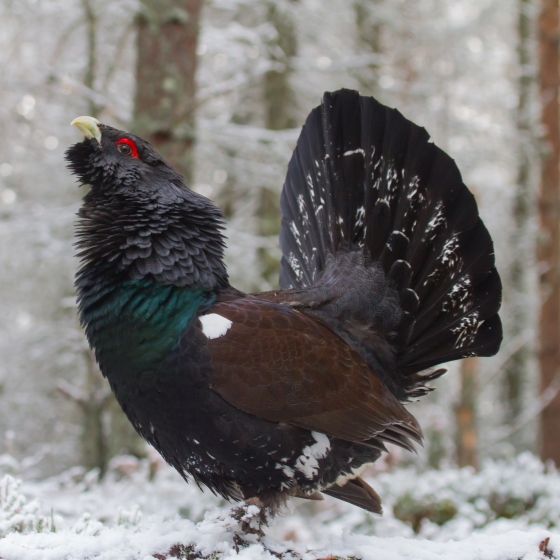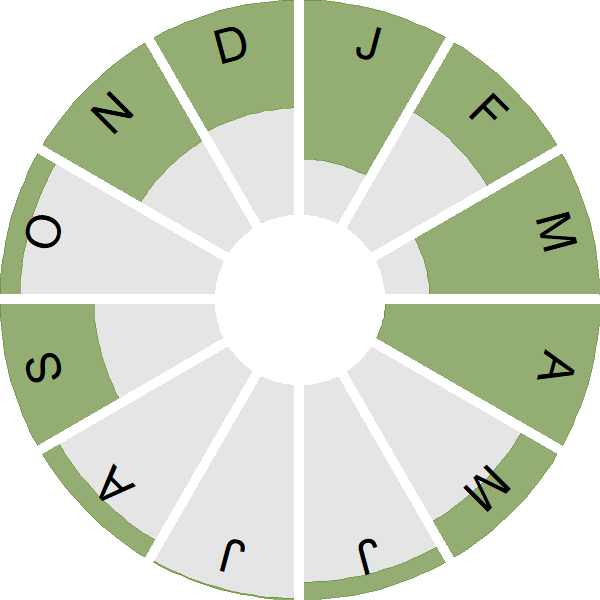Capercaillie

Introduction
This very large bird, now confined to the pine forests of northern Scotland, once had a wider distribution within Britain & Ireland
A male Capercaillie, with his red eye surround, bone-coloured beak, and beautiful dark plumage, is about a third larger than the more cryptically-coloured hen. Often occurring at low density within extensive areas of pine forest, this is a challenging bird to see and to study.
Capercaillie numbers and range have undergone significant declines here since the 1970s, with a number of factors - including changes in forest habitat and increased levels of predation and disturbance - implicated in the decline.

Key Stats
Identification
ID Videos
This section features BTO training videos headlining this species, or featuring it as a potential confusion species.
Grouse
Songs and Calls
Song:
Call:
Status and Trends
Conservation Status
Population Size
Population Change
This species was reintroduced to Scotland in the 1830s having gone extinct in eighteenth century (Ritchie 1920). Substantial declines are believed to have occurred between the 1970s and early 1990s (Moss 1994). Capercaillie have subsequently been monitored by single-species surveys which take place during winter and these show a further decline from an estimate of 2,200 individuals during the first survey in 1992–94 (Catt et al. 1998) to 1,114 birds in winter 2015/16 (Wilkinson et al. 2018). A sixth national survey was due to take place in winter 2021/22 (Eaton et al. 2021). The Atlas maps show that a range decline has also occurred, from 182 10-km squares during the breeding season in 1968-72 to 51 squares in 2007-11 (Balmer et al. 2013).
Distribution
Capercaillies are confined to pine forests in the north of Scotland. As a resident species and fairly sedentary, the distribution maps for the winter and breeding season are broadly similar. They highlight the core areas in Easter Ross, Strathspey and Aberdeenshire. Only a few other occupied sites remain outwith this area, in Inverness-shire, Perthshire and Dunbartonshire.
Occupied 10-km squares in UK
2007/08–10/11
or view it on Bird Atlas Mapstore.
2008–11
or view it on Bird Atlas Mapstore.
European Distribution Map
Distribution Change
A large decline in Capercaillie numbers is manifested in a 55% decrease in the number of occupied 10-km squares since the 1981–84 Winter Atlas, and a 73% reduction in range size in the breeding season since the 1970s.
Change in occupied 10-km squares in the UK
from 1981–84 to 2007–11
or view it on Bird Atlas Mapstore.
from 1968–72 to 2008–11
or view it on Bird Atlas Mapstore.
Seasonality
Capercaillies are an elusive and declining bird, recorded sporadically throughout the year.
Weekly pattern of occurrence
The graph shows when the species is present in the UK, with taller bars indicating a higher likelihood of encountering the species in appropriate regions and habitats.

Movement
Britain & Ireland movement
Foreign locations of birds ringed or recovered in Britain & Ireland
Dots show the foreign destinations of birds ringed in Britain & Ireland, and the origins of birds ringed overseas that were subsequently recaptured, resighted or found dead in Britain & Ireland. Dot colours indicate the time of year that the species was present at the location.
- Winter (Nov-Feb)
- Spring (Mar-Apr)
- Summer (May-Jul)
- Autumn (Aug-Oct)

European movements
EuroBirdPortal uses birdwatcher's records, such as those logged in BirdTrack to map the flows of birds as they arrive and depart Europe. See maps for this species here.
The Eurasian-African Migration Atlas shows movements of individual birds ringed or recovered in Europe. See maps for this species here.
Biology
Productivity and Nesting
Nesting timing
Egg measurements
Clutch Size
Survival and Longevity
Survival is shown as the proportion of birds surviving from one year to the next and is derived from bird ringing data. It can also be used to estimate how long birds typically live.
View number ringed each year in the Online Ringing Report.
Lifespan
Survival of adults
Survival of juveniles
Biometrics
Wing length and body weights are from live birds (source).
Ring Size
Classification, names and codes
Classification and Codes
- Order: Galliformes
- Family: Phasianidae
- Scientific name: Tetrao urogallus
- Authority: Linnaeus, 1758
- BTO 2-letter code: CP
- BTO 5-letter code: CAPER
- Euring code number: 3350
Alternate species names
- Catalan: gall fer comú
- Czech: tetrev hlušec
- Danish: Tjur
- Dutch: Auerhoen
- Estonian: metsis e. mõtus
- Finnish: metso
- French: Grand Tétras
- Gaelic: Capall-coille
- German: Auerhuhn
- Hungarian: siketfajd
- Icelandic: Þiður
- Irish: Capall Coille
- Italian: Gallo cedrone
- Latvian: mednis
- Lithuanian: vakarinis kurtinys
- Norwegian: Storfugl
- Polish: gluszec (zwyczajny)
- Portuguese: tetraz-real
- Slovak: hluchán hôrny
- Slovenian: divji petelin
- Spanish: Urogallo común
- Swedish: tjäder
Research
Causes of Change and Solutions
Causes of change
Factors which are believed to have contributed to the decline include lower breeding productivity as a result of changes to the climate (in particular delayed spring weather), and increased mortality, in particular from collisions with deer fences (Moss et al. 2000, 2001; see also summary paragraph in Wilkinson et al. 2018). Conservation action to prevent collisions by removing or marking fences has been shown to be successful at reducing mortality (Baines & Andrew 2003; Summers et al. 2010).
Information about conservation actions
Lots of info on possible conservation actions in Wilkinson et al. 2018
More Evidence
More evidence from Conservation Evidence.com
Partners
Citing BirdFacts
If you wish to cite particular content in this page (e.g. a specific value) it is best to use the original sources as linked in the page. For a more general citation of the whole page please use: BTO (20XX) BirdFacts Species: profiles of birds occurring in the United Kingdom. BTO, Thetford (www.bto.org/birdfacts, accessed on xx/xx/xxxx).

